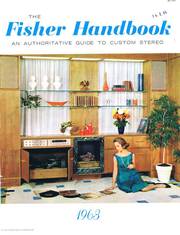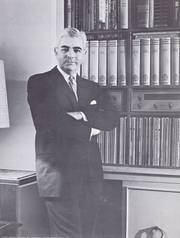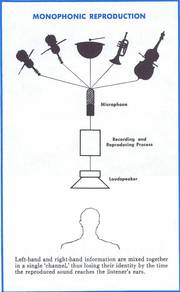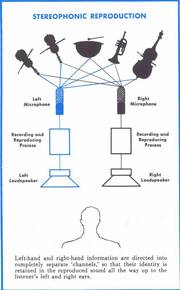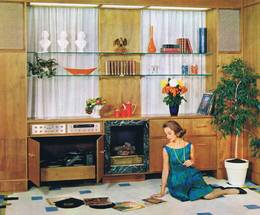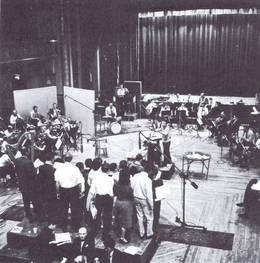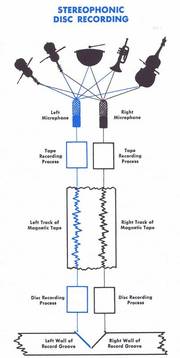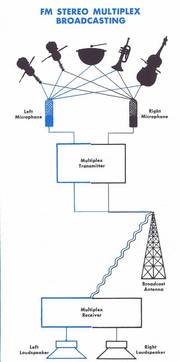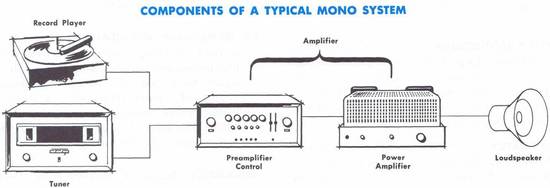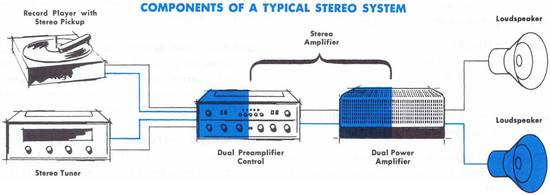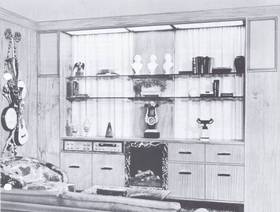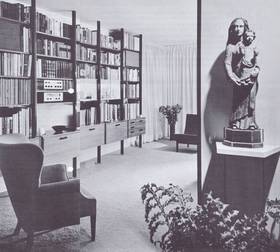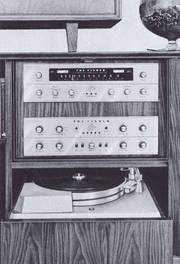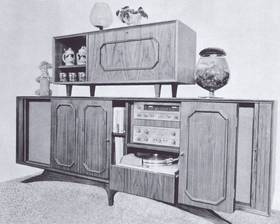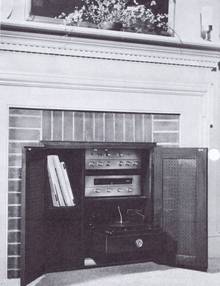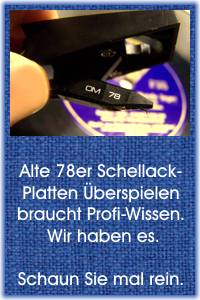Im Februar 1964 bekam man noch den 1963er Herbst Prospekt
Und jetzt wurde es sogar richtig bunt, also nicht nur zweifarbig. Der Wettbewerb wurde härter, es kamen immer mehr kleine und größere Firmenauf den Markt, die sich bei Scott, Fisher, Radishack und Heathkit ein Stück von dem offensichtlich lukrativen Kuchen sichern wollten.
Und ab jetzt waren es aufwendige "The Fisher Handbook"s mit allem Drum und Dran. Wir dürfen nicht vergessen, für einen Amerikaner gab es 1964 fast nur soetwas wie unsere damaligen Neckermann- und Quelle Kataloge zum Beispiel von Sears, einem der größten Versandhändler.
Beratung war da einfach nicht möglich, der nächste Shop war "meilenweit" entfernt. Wenn ich in den USA von "meilenweit" spreche, dann sind das 200 Meilen oder noch mehr, also 300 bis 400 Kilometer, um in ein Hifi-Studio zu kommen.
So gab es in jedem Magazin oder Fachzeitschrift kleine Abreißkarten zum Anfordern von Unterlagen und darin musste alles drin sein, auch, wie zum Beispiel Stereo auf UKW (FM) funktioniert und daß es das bei AM (Mittelwelle) einfach nicht gibt.
Ach und noch etwas. Wie damals bei unserer ach so tollen Bundespost waren auch in USA Ferngespräche (sogenannte "long distance calls") richtig teuer. AT&T hatte ein quasi Monopol wie die Bundespost und das hatten sie weidlich umgesetzt (andere nannten das auch "Ausnutzen").
.
The Fisher Handbook Herbst/Winter 1963 (Teil 1 - Vorwort)
"THE FISHER TRADITION"
If a cross section of serious music lovers were asked to list their requirements for a theoretically 'ideal' manufacturer of high-fidelity equipment, the chances are they would reply with a fairly accurate description of the Fisher Radio Corporation.
They would undoubtedly want the head of the company to be a devoted music lover himself, preferably a trained musician, and most certainly an avid record collector. Avery Fisher is all three—chamber music enthusiast, violinist, and owner of one of the country's major record collections as well as an unusually rare library of chamber music.
They would want the company to be deeply aware of every problem faced by the discriminating home music listener, of every major and minor trend in high fidelity, of even the slightest new development in audio engineering, and to have vast experience in translating this awareness into the finest equipment.
Avery Fisher built his original high-quality radio and phonograph systems in 1937, as much for himself as for his handful of knowledgeable patrons, at a time when 'high fidelity' was strictly professional jargon and natural-sounding equipment designed specifically for the home desperately scarce. Since then, he and the Fisher Radio Corporation have been responsible for more engineering 'firsts' in high fidelity than all other companies together. (See complete list of Fisher Firsts on inside back cover.)
Today, in the age of stereo, Fisher components built in 1937 are still in use — and the 1963 Fisher components are again considered by engineers and musicians alike to be the finest available in their respective categories.
One could draw many other parallels between the music lover's desires and "The Fisher Tradition". The important thing, however, is that the Fisher Radio Corporation is as deeply steeped in music itself as in technical know-how and that each new Fisher component design, before it can go into production, must satisfy not only a staff of the most experienced audio and radio engineers to be found anywhere but also the ears of a man who knows what a real violin sounds like.
Since those early beginnings more than 25 years ago, some of the world's most prominent people — heads of state, royalty, leaders of industry and of the sciences and professions—have joined the roster of Fisher owners. Throughout the world, they represent the truest index to the meaning and worth of the Fisher brand name — the international synonym for high-quality sound reproduction.
None of this, however, gives Avery Fisher nearly as much satisfaction as the fact that many of today's greatest musical artists choose Fisher equipment to hear their own recordings in their homes. The President of the Fisher Radio Corporation considers himself to be the firm's most demanding patron and he is pleased that his standards meet the most advanced musical tastes throughout the world.
What is stereo ?
The stereophonic reproduction of sound in general and of music in particular, now called 'stereo' for short, is a subject of considerable complexity at the engineering level. There is no reason, however, why the average music lover and record collector should not easily and clearly understand what stereo means to him, what it has to offer in terms of living-room listening and how to get the most out of it.
The first thing that must be made clear is that stereo is not a new development which has somehow replaced an older technique known as high fidelity (or 'hi-fi').
Stereo "is" high fidelity - potentially the highest fidelity there is. 'High fidelity' means, and cannot be correctly interpreted to mean anything other than, a high degree of faithfulness. In the case of sound reproduction, the faithfulness is to the original, 'live' sound.
- Anmerkung : "Stereo "is" high fidelity" ist natürlich populistischer Unsinn. Stereo hat mit "Hifi" erstmal überhaupt nichts zu tun. Es gibt "Hifi" in Mono und es gibt "Stereo" ohne Hifi. Das alles hatte Karl Breh bei uns bereits 1962 gerade gerückt in den ersten Hifi-Stereophonie Ausgaben. Warum das hier so falsch beschrieben wird, es spricht nicht für den Autor.
Stereo is today's most advanced technique for recreating with the highest possible degree of faithfulness the subjective experience of listening to live sound. Therefore any question like, "Are you buying a hi-fi or a stereo?" is utterly meaningless. This Handbook is about stereophonic high fidelity - or stereo hi-fi, if you prefer.
Stereo differs from the older methods of sound reproduction in that it recreates the space where the original sound occurred, as well as the other important characteristics of the sound. Before the advent of stereo, great strides were made in reproducing timbre (the exact shades of tone color) and dynamic range (the contrasts between loud and soft), but the reproduction still lacked dimension — there was no distinction between left and right, up and down, front and back. These spatial characteristics can now be restored to the reproduction by means of the new stereo techniques, so that the reproduced sound retains not only its original quality and individuality but also its original acoustic environment: it has the elements of direction and depth.
Our ability to hear direction and depth is based on the simple fact that we have two ears. Anyone can convince himself of this basic phenomenon of nature by attempting to lead a normal life with one ear plugged for a few hours. Sounds become shallow and confused; there seems to be a strange lack of contact with audible 'reality'. Stereo is designed to satisfy our instinctive need for two-eared hearing and is thus the natural method of sound reproduction.
Let us consider an actual, live listening situation, such as a concert. The sounds that reach one's left ear are slightly different most of the time from those that reach the right ear. Instruments playing to the left of center are heard by the left ear a fraction of a second sooner than by the right ear; instruments to the right of center are heard sooner by the right ear.
The sound of instruments playing in dead center reaches both ears at exactly the same instant. These differences and similarities in arrival time enable us to distinguish the direction of each sound. The sounds reflected from the walls of the concert hall by reverberation reach one's ears slightly later than the direct sound, and this information is also sorted out in the same fashion by both left and right ear. Combined with the differences in loudness between near and far sounds, these directional 'echo' effects help us to judge the size of the concert hall, the distance of each instrument and all the other elements that contribute to the depth of the sound.
This is a somewhat oversimplified summary of how we hear sounds in space, but the important thing to remember is that the entire process is based on differences occurring simultaneously. Now, there can exist a difference only between two or more things—and that's precisely where monophonic reproduction in any form, was inadequate. It gave us only a single pattern of sound; just one spiral pattern of wiggles on a phonograph record, just one magnetic track on a recorded tape, just one optical track on a sound film, just one signal transmitted by a radio station.
It did not matter how many microphones were used to pick up the original sound; their outputs all ended up in one mixture in the same single channel. Nor did it matter how many loudspeakers the ultimate listener had; each loudspeaker was fed from the same single channel and each was in effect playing the same pattern of sound. No differences for the ear to sort out — therefore no spatial information.
Stereo, on the other hand, provides two or more channels of sound, kept distinct and separate throughout the entire process of reproduction. Not just two or more microphones, not just two or more loudspeakers, but two or more completely different patterns of sound.
As many as seven such separate channels have been used for special stereo applications, but in normal practice two channels have been found completely adequate and a spectacular improvement over one. Separate is the key word here — one could dramatize the principle by saying that one channel does not even know that the other exists until both emerge into the listening room. Then the listener's ears have a chance to perceive differences and interpret them as spatial information.
It is entirely incorrect to say that stereo provides "one channel for the left ear and one for the right ear." In listening to stereo, both ears hear both channels — all the time. But the two channels are different; and the left ear hears the left channel a little sooner than the right ear, the right ear hears the right channel a little sooner than the left ear — and if there are more channels (as there are in certain special installations), still further differentiation is possible. That's what produces the stereo effect.
It should also be clear that each channel in stereo must be of the highest possible quality if a real improvement in fidelity is to be achieved. Distortion, noise and other obstacles to high fidelity must be as carefully kept out of both channels as out of the single channel of mono-phonic days. In the final analysis, stereo has not changed the basic requirements of high-quality sound reproduction; it has merely multiplied them.
How is stereo recorded and broadcast?
Until approximately five years ago (Anmerkung: aktuell wäre es gerade Herbst 1963), stereo was almost exclusively a tape recording technique. Two or more microphones were set up in front of or above the sound source, in positions experimentally determined by the recording engineers as the best possible for the particular room or hall and for the type of sound to be recorded.
The sound picked up by each microphone was then separately recorded on one of the two or more parallel and simultaneous magnetic tracks of a single tape. All of the tracks started together and ended together on the same reel, but each track was in effect an independent tape recording of the sound 'heard' by a single microphone.
These parallel tracks could then be played back simultaneously, just as they had been recorded, each through a separate high-fidelity system terminating in a separate loudspeaker. The result was multi-channel (usually two-channel) stereo reproduction of the highest order, and this is still the method used today to make the original 'master' recording at a recording session.
Wie bekomme ich Stereo auf die Schallplatte oder in die Rille ?
Until recently, however, it was difficult to make such stereo recordings available in many copies for commercial distribution. Methods were slowly developed to make tape copies available in quantity to owners of home-type, nonprofessional tape recorders, which have a slower tape speed than the studio recorders. Today these commercial stereo tapes are widely available in record stores and other outlets, and they are very close in sound quality to the original master tape. The big problem that remained to be solved was to adapt stereo to the most widely used high-fidelity medium - the phonograph record.
The solution came in 1957 in the form of the Westrex system of stereo disc recording. This technique permits the recording of two separate channels on the two walls of a single V-shaped record groove. The two separate tracks of a stereo master tape can thus be easily re-recorded on a disc, or a two-channel original recording can be made directly on a master disc, even though the latter technique is, for a variety of reasons, out of the ordinary. The important thing is that a single record side with a single groove engraved on it can now hold two separate simultaneous recordings - for the left and right channels of two-channel stereophonic sound reproduction.
Pickups have been developed which can decipher the complex information in a stereo record groove, keep the two channels entirely separate and feed them to two separate playback systems. Furthermore, the same pickups can also play single-channel or monophonic records with even greater fidelity than conventional 'mono' pickups.
The complexity of the new stereophonic disc recording and playback system necessitated a few very minor compromises with fidelity in the first year or so of commercial practice. Today, however, the finest stereo discs and pickups bring an unprecedented degree of fidelity to sound reproduction in the home — provided the rest of the playback system is also of the highest quality.
The last medium to take advantage of stereophonic techniques was radio. Certain stations have been experimenting for a number of years with FM-AM stereo: broadcasting one channel on FM and the other on AM. These transmissions left a great deal to be desired, since the AM channel was invariably noisier and more distorted than the FM channel, creating imbalances that largely destroyed the stereo illusion.
The solution had to be pure FM stereo radio, which became a reality in the latter part of 1961 with the advent of Multiplex FM broadcasting. This new system uses only one FM transmitter to broadcast both channels; the two channels are combined in a predetermined and highly ingenious manner before transmission and are then separated and restored to their original patterns by the receiving equipment, just as though they had never been mixed in the first place. The latest FM-Multiplex receiving equipment has built-in facilities to accomplish this; earlier models require the addition of what is known as a Multiplex Adaptor.
What do I need?
There is a popular misconception that "you need two of everything for stereo." This may have been at least a partial truth in the days when none of the high-fidelity component manufacturers had a full line of stereo equipment on the market, so that the second channel had to be more or less a duplicate of the equipment one already owned. Today's stereo components are invariably of duplex design — two-channel amplifiers, FM tuners with built-in Multiplex, dual-cable pickup arms and so on.
They are not nearly as costly as two single-channel components of equivalent quality. Integrated design eliminates many unnecessary duplications and makes important savings possible. Loudspeakers remain the only item of which one still needs a pair, and even here there are ways to avoid doubling the mono budget.
Let us begin with the selection of the AMPLIFIER.
They are illustrated in the diagrams below.
If we regard a high-fidelity system as a sort of operational pipeline carrying information from the record groove or the radio antenna through the various components all the way to the loudspeaker, then the Amplifier is the central pumping station. It receives very weak currents from the various program sources and it builds up or 'amplifies' these currents until they are powerful enough to drive the loudspeaker or loudspeakers. Its output is regulated by the volume control and its maximum power is rated in watts.
Approximately 15 watts per channel is the rating where acceptable stereo amplifiers begin. Such an amplifier would be described as a 30-watt stereo amplifier or as a 'dual 15.' More power is required if the loudspeakers to be used are relatively difficult to drive (a factor which has nothing to do with their sound quality) or if the listening room is large or heavily draped and carpeted. The advice of a competent high-fidelity component salesman can be invaluable in making the correct choice.
Another function of the Amplifier is to compensate for tonal imbalances (too little bass, too strong high tones, and the like) in the program sources and to make these and other adjustments easily controllable by the listener. This is accomplished by means of various controls and switches, as is the selection of the program source itself.
The part of the amplifier incorporating these controls (as well as the volume control) is known as the 'front end' or Master Control section. In certain elaborate design, it is on a separate chassis by itself, apart from the main or power amplifier. Amplifiers that include the control section on the same chassis with the main amplifier are classified under the name of Control Amplifiers.
Feeding the front end of the amplifier are the various program sources or services — the Radio Tuner (FM or AM or FM-AM as the case may be), the Record Player and possibly a Tape Recorder.
The function of the tuner is to receive radio programs off the air and convert them to electrical signals that are suitable for amplification. Only FM programs are comparable, in fidelity and freedom from noise, to records or tape, and discriminating music lovers now tend to depend on them almost exclusively. The majority of important stations duplicate all their programs on FM.
The RECORD PLAYER can be either a record changer with a pickup cartridge or a single-play turntable with separately mounted pickup arm and cartridge. The stylus (or, less correctly, 'needle') of the cartridge traces the vibrations engraved in the record groove and translates them into tiny electric currents, to be fed to the front end of the amplifier. The function of the remaining parts of the record player is merely to rotate the record evenly and steadily, and to guide the cartridge in a correct position over the record surface. The absence of vibration, noise, extraneous resonances, and interference with steady rotation is the major criterion of quality here. Good record players "should be seen and not heard" — except for the output of the cartridge.
About the speakers
The output side of the amplifier, where the current has been built up to sufficient strength to do physical work, is connected to the loudspeaker. The function of the Loudspeaker is to translate the electrical signals fed to it by the amplifier into mechanical vibrations (similar to the rapid motions of a piston), thus creating audible sound waves in the listening room. Advanced high-fidelity loudspeakers are, more properly stated, loudspeaker systems, consisting of several individual loudspeakers — a heavy one (woofer) for the very hard-working low tones; a small and very precise one (tweeter) for the delicate upper tones; and in some cases a medium-sized one for the middle range.
Stereo requires the use of two separate loudspeaker systems, each connected to one of the two channels of the stereo amplifier. They should be placed the proper distance apart, which may be as little as 4 feet or as much as 15 feet, depending on the size and shape of the listening room. Having the speaker systems too close together destroys the stereo effect; placing them too far apart creates an acoustic 'hole in the middle.' In a very large room, where the speakers must be very widely spaced to cover the listening area, a third speaker system may be added in the center, receiving the mixed outputs of both channels.
Conversely, in a small room, a satisfactory stereo illusion can be created by feeding both channels into a single high-quality speaker system in a center location and connecting two smaller 'outrigger' or wide-surround systems (covering the middle and high tones only), to the left and right channels, respectively. Again, the advice of an expert salesman can be of great help in making the right selection.
In general, the loudspeaker systems selected for stereo should be small enough so that they can be freely moved to find their best possible location. Stereo has forced into eclipse the monster speaker systems of monophonic days; two of the latter are too much for the average home, and the more sophisticated smaller designs of the stereo era do just as well, often better. One should invest as much of the stereo budget as possible in the very best loudspeaker systems one can afford, because there is a tremendous difference in sound quality between good, better and best in the loudspeaker field. Amplifiers, tuners, cartridges and other components are getting close to technical perfection today, but the loudspeaker still depends very much on the kind of inspired design that is fifty percent science and fifty percent art. It is advisable to listen very carefully before buying.
Where available space for a complete stereo component system is limited, or where it is desired to acquire the necessary components in the most economical form, without sacrifice of basic quality, the solution may well be a relatively new type of component — the Stereo Receiver. It combines dual radio, dual master controls and dual amplifiers on a single compact chassis, requiring only the connection of two loudspeaker systems and a record player for a complete, ready-to-play stereo installation.
There are available three basic combinations of the components just discussed for assembling a complete custom stereo system, including both phonograph and radio.
.
How to decorate your home with music
You can conceal or display your stereo components in your listening room and achieve a handsome installation either way. With their designer-styled front panels and fine furniture-wood cabinets, Fisher tuners, amplifiers and receivers can even be displayed on an open shelf, if you so desire. Fisher loudspeakers are eye-flattering pieces of furniture in themselves, so you may want to leave them out in the open, too.
On the other hand, there is no limit to the ways you can hide a stereo installation, if you prefer it that way. Breakfronts, sideboards, drawers, closets, wall cabinets, bookcases and unused old pieces from your attic can make perfect housings for stereo. Your imagination can stand you in good stead here. On the next few pages, you will see outstanding examples of how others have solved their installation problems.
A little ingenuity goes a long way !
We have had the privilege of supplying Fisher instruments for special installations in fine homes throughout the world. Our twenty-five years of experience in this field is so vast and varied as to be truly without equal.
The benefit of that experience is yours to draw upon when planning a stereo installation. On these pages we are showing for your guidance and inspiration photographs of actual installations in the homes of Fisher owners.
They were selected as most typical and they cover a great variety of arrangements. Every installation reflects careful planning and the I most efficient and convenient utilization of the available space. Ample ventilation is provided in every case, to assure a long, trouble-free life for the equipment.
When you plan your stereo installation, always remember two basic requirements:
Electronic components must have adequate ventilation and loudspeakers must be properly placed for good stereo effect.
Never have a tuner, amplifier or receiver in a completely enclosed space. There must be access to the cooler outside air, preferably through substantial openings, for proper air flow.
Never place stereo loudspeakers less than four feet or more than 15 feet apart, nor position them in such a way that one is much closer to the listening area than the other.
.
Otherwise, there is no limit to the number of ways you can exercise your ingenuity in placing your stereo components. Should you need help in planning the installation of your stereo system, the services of our Mr. Richard Hamilton are available to you. Simply send us (either through your dealer or directly) a rough sketch of your room layout, the dimensions of the space available for installation of the electronic equipment, and your choice or preference of the FISHER models in the system planned. Mr. Hamilton will advise you on how to make the most effective use of the cabinet space as well as the room acoustics.
.
How to keep components in their place
You can plan a custom stereo installation to suit every room dimension, every room acoustic. Should the general features of your room suggest the use of completely exposed components, rather than built-ins, you can select from three basic cabinet finishes: Walnut, Mahogany, or Metal Cabinet in simulated leather. Most of the new 1963 FISHER components are designed to accommodate any of these three basic cabinet styles.
.

